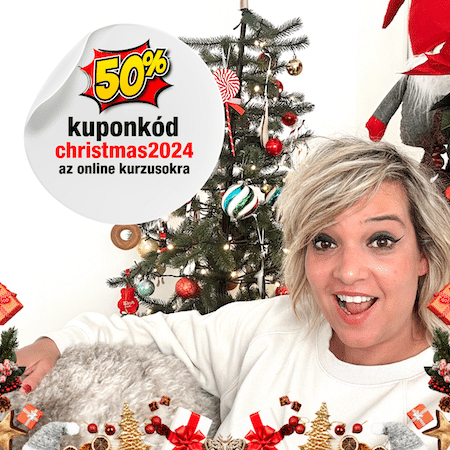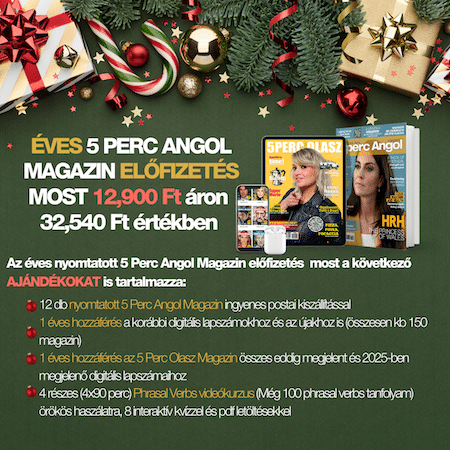Szia,
Ma tovább folytatjuk a karácsonyozást, és ellátogatunk képzeletben néhány európai karácsonyi vásárba! A szöveghez hanganyag is tartozik!
A karácsonyi ajándékokkal kapcsolatban is van egy tippem számodra: használd az 50% engedményt adó kuponkódot, amely érvényes szinte minden videókurzusra (örökös hozzáféréssel), ráadásul számos könyv és kártya is kedvezménnyel kapható most.

KUPONKÓD: christmas2024
Ezt kell vásárlás végén begépelned, hogy az 50% kedvezményt érvényesíteni tudd! Remélem találsz valami kedvedre valót!
A nyomtatott magazinra pedig most nagyon megéri előfizetni, hiszen a már megszokott digitális előfizetés ajándék (+ hozzáférés 2012-ig minden lapszám digitális verziójához) mellé egy Phrasal Verbs videókurzust is kapsz (“Még 100 phrasal verbs”) SŐT az 5 Perc Olasz Magazinhoz is kapsz egy éves digitális előfizetést (+ hozzáférsz minden korábbi lapszámhoz digitálisan) – a fiókot a www.5percolasz.hu oldalon kell ehhez létrehoznod.

Most pedig nézzük a leckét!
Üdv,
Nóri
MAI LECKE
The best Christmas markets in Europe
a szöveghez tartozó audiót itt hallgathatod meg: MEGHALLGATOM
Whether in the historic squares of Prague or beautiful gardens of Copenhagen, you can pick up unique presents and experience European traditions.
Budapest
Traditional food, folk dances and live music can be found daily in amongst the cottage-esque market stalls of Vörösmarty tér from mid-November. Based at the centre of the Pest district near the start of ‘Fashion Street’, this market regularly has up to 150 stalls, and plenty of local art and culture, including puppet theatres. To add to the authenticity of celebrations, all products sold in the market are guaranteed as traditionally handmade by the Association of Hungarian Folk Artists. The market also has a gastronomic side. Visitors can taste traditional Hungarian foods like kenyérlángos (a flat bread like dough cooked in a cob oven), kürtőskalács (a cone-shaped sweet yeast cake), rétes (strudel), pecsenye (roast meats), and last but not least, the most of typical winter drinks, forralt bor (mulled wine).
Berlin
Berlin could easily be described as the capital of the Traditional Christmas Market, if judged on quantity alone – it has sixty markets across the city this year. The most popular and most visited, with around four million visitors last year, is the one that takes place around the Kaiser Wilhelm Gedächtniskirche. The market isn’t as large as one might expect, with around one hundred stalls, housed in traditional rustic and wooden. There’s the usual array of traditional arts, crafts and Christmas decorations, but the fact that the city is home to some of Europe’s leading cutting-edge artists and designers, you have to visit this place. You can also find there a good selection of more radical artworks and decorations, as well as an eclectic selection of antique and contemporary jewellery.
Munich
The focal point of Munich in December is the famous Marienplatz, the heart of the old centre, flanked by the grand neo-gothic town hall and filled with hundreds of stalls in the run-up to Christmas. There are a number of smaller markets dotted around the city, but this is the largest and dates back to the 17th century. The market is inaugurated on the Friday before the first Advent, when thousands gather in the square to watch the thirty metre-high Christmas tree light up for the first time. Over 140 stalls are set up in the square, selling hand-carved wooden Christmas decorations, glass baubles, jewellery, arts and crafts.
Barcelona
Dating from 1786, this traditional Christmas fair has expanded to more than 300 stalls selling all manner of handcrafted Christmas decorations and gifts, along with mistletoe, poinsettias and Christmas trees. The most popular figure on sale for Nativity scenes is the curious Catalan figure of the caganer (crapper), a small figure crouching over a steaming turd with his trousers around his ankles. There’s also a Nativity scene contest, musical parades and exhibitions, including the popular life-size Nativity scene in Plaça Sant Jaume.
Prague
The Czechs take Christmas seriously, and the capital hosts a number of cultural events, folk displays, concerts and theatre in December. Prague’s Christmas markets takes place in Old Town Square and Wenceslas Square. The idyllic Baroque setting of the cobbled square seems perfectly suited to a quaint seasonal market. A central petting zoo, complete with ponies, goats and sheep, is the big attraction for kids. The rows of colourfully decorated wooden huts stock some attractive hand-made stocking fillers, including the locally made wood-carved puppets, jewellery, toys and candles. You may also find some good deals on Bohemian crystal. A central stage hosts daily carol singers and bands playing seasonal tunes.
Vienna
Winter is the most quintessentially Austrian time of year: snow blankets the city and the Christmas markets appear. The ‘Christkindlmarkt’ on the square in front of the magnificent Town Hall is Vienna’s classic Christmas market. It is one of the best-known and most visited in Europe, attracting millions of visitors to its rows of wooden huts leading up to the Hall. It is certainly one of the oldest, dating back over seven hundred years, and starts early – from mid-November – which is handy for those, who wants to avoid the pre-Christmas crowds. Christmas for the Viennese is a social affair, where people meet up at the markets for Punsch or Glühwein (the local mulled wine), chestnuts and spicy Christmas cookies. The Vokshalle, within the Town Hall, is home to a daily workshop for kids in Viennawhere parents can drop them off to make presents and bake Christmas cookies. An added attraction is that throughout December choirs from around the world perform in the Festival Hall at weekends.
Brussel
Christmas in Brussels seems to get bigger every year. The Christmas Market now extends along the streets from Grand’Place to place Ste-Catherine, covering almost 2 kilometres. Each market stall is a little wooden-roofed hut selling mainly arts and crafts or food and drink, all of them having a pan-European flavour. The Fish Market is transformed into a temporary ice rink in December, making it a big attraction for locals. Carols are filtered through loudspeakers, and jugglers, street musicians and painters brave the cold to entertain the crowds. From December 23rd, many of the stalls switch hands, and the market becomes more of a gastronomic affair.
Copenhagen
Europe’s oldest amusement park, the Tivoli Gardens, hosts Copenhagen’s annual Christmas market. The setting is out of Hans Christian Andersen, with hundreds of Christmas trees and over half a million lights illuminating the stalls and park. There are plenty of food stalls – the main draw here is glögg, Danish mulled wine mixed with liquor and spices. Hot apple dumplings make for a warming mid-shopping snack. Based in the centre of the capital it attracts up to a million visitors, so expect crowds.
historic square [hɪˈstɒrɪk skweə] – történelmi tér
to pick up [tu pɪk ʌp] – talál, szerez
cottage-esque [ˈkɒtɪdʒ ˈesk] – kunyhószerű
stall [stɔːl] – stand, árusító bódé
puppet theatre [ˈpʌpɪt ˈθɪətə] – bábszínház
authenticity [ˌɔːθenˈtɪsəti] – hitelesség
handmade [hændˈmeɪd] – kézzel gyártott
dough [dəʊ] – tészta
cob oven [kɒb ˈʌvən] – kerti (kő) sütő
cone-shaped [kəʊn ʃeɪpt] – kúp alakú
yeast cake [jiːst keɪk] – élesztővel készült sütemény
rustic [ˈrʌstɪk] – falusias
array of [əˈreɪ ɒv] – valamin elrendezése
craft [krɑːft] – kézművesség
cutting-edge [ˈkʌtɪŋ edʒ] – legmodernebb, legjobb
eclectic [ɪˈklektɪk] – összeválogatott
jewellery [ˈdʒuːəlri] – ékszerek
to flank [tu flæŋk] – oldalról támogatott
run-up [ˈrʌn ʌp] – rákészülés, felfutás
dotted [ˈdɒtɪd] – tarkított
to inaugurate [tə ɪˈnɔːɡjʊreɪt] – felavat
to gather [tu ˈɡæðə] – valahol üsszegyülés
to light up [tu laɪt ʌp] – kivilágít
to set up [tu set ʌp] – felállít
hand-carved [hænd kɑːvd] – kézzel faragott
glass bauble [ɡlɑːs ˈbɔːbəl] – üveg csecsebecse
all manner of [ɔːl ˈmænər ɒv] – mindenféle valamiből
mistletoe [ˈmɪsltəʊ] – fagyöngy
poinsettia [poɪnˈsetɪə] – mikulásvirág
Nativity [nəˈtɪvɪti] – Krisztus születése
curious [ˈkjʊərɪəs] – furcsa, különös
crapper [kræpə] – ürítő, kakiló
to crouch over [tu kraʊtʃ ˈəʊvə] – valami felett guggol
steaming turd [ˈstiːmɪŋ tɜːd] – gőzölgő ürülék
life-size [ˈlaɪf saɪz] – életnagyságú
Old Town Square [əʊld taʊn skweə] – Óváros tér
Wenceslas Square [wenceslas skweə] – Vencel tér
cobbled [ˈkɒbəld] – macskaköves
quaint [kweɪnt] – furcsa és régies
petting zoo [ˈpetɪŋ zuː] – állatsimogató
wooden hut [ˈwʊdən hʌt] – fakunyhó
to stock [tu stɒk] – raktáron tart
stocking fillers [ˈstɒkɪŋ ˈfɪləz] – karácsonyi ajándékok
candle [ˈkændəl] – gyertya
Bohemian [bəʊˈhiːmɪən] – cseh
quintessentially [quintessentiallei] – tömören
blanket [ˈblæŋkɪt] – takaró
to lead up [tu liːd ʌp] – felvezet
handy [ˈhændi] – kényelmes, alkalmas
social affair [ˈsəʊʃəl əˈfeə] – társasági esemény
chestnut [ˈtʃesnʌt] – gesztenye
wooden-roofed hut [ˈwʊdən ruːft hʌt] – fafedelű kunyhó
craft [krɑːft] – kézművesség
flavour [ˈfleɪvə] – sajátosság, légkör
ice rink [aɪs rɪŋk] – műjégpálya
to filter [tu ˈfɪltə] – átszűrődik
loudspeaker [laʊdˈspiːkə] – hangszóró
juggler [ˈdʒʌɡlə] – zsonglőr
brave the cold [breɪv ðə kəʊld] – tűri/bírja a hideget
switch hand [swɪtʃ hænd] – tulajdonost vált
amusement park [əˈmjuːzmənt pɑːk] – vidámpark
illuminating [ɪˈluːmɪneɪtɪŋ] – világító
apple dumpling [ˈæpəl ˈdʌmpəlɪŋ] – bundás alma
mid-shopping [mɪd ˈʃɒpɪŋ] – vásárlás közepi



